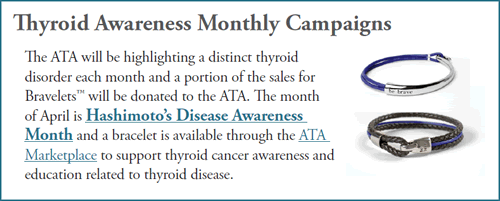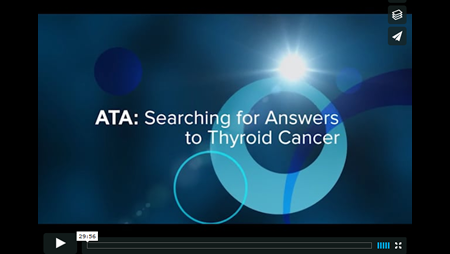Clinical Thyroidology for the Public summarizes selected research studies discussed in the previous month’s issue of Clinical Thyroidology, an official publication of the American Thyroid Association. Editor-in-chief, Alan Farwell, MD, FACE
Available in pdf format for saving and printing and Web page format for viewing online
PDF Format for Saving and Printing
Clinical Thyroidology for the Public Volume 13 Issue 4 (PDF file, 7.5 MB)
TABLE OF CONTENTS – Web Format
TABLE OF CONTENTS – Web Format
STATEMENT ON COVID-19 (PDF File for saving and printing, 717 KB)
NOVEL CORONAVIRUS (COVID-19) 4 AND THE THYROID: FAQS
(PDF File for saving and printing, 861 KB)
HYPERTHYROIDISM .
Is there a risk of cancer following radioactive iodine therapy for hyperthyroidism?
Radioactive iodine therapy can be a valuable option to treat hyperthyroidism. However, since it exposes many non-thyroid tissues to radiation, a number of studies have been done to look for any association between radioactive iodine therapy and subsequent cancers. This study was performed to evaluate the risk of cancers in patients who were diagnosed with hyperthyroidism and then treated with radioactive iodine therapy.
Gronich N et al 2019 Cancer risk following radioactive iodine treatment for hyperthyroidism: A cohort study. Thyroid 2020 Feb;30(2):243-250.
(PDF File for saving and printing, 938 KB)
GRAVES’ DISEASE
Steroids are effective for preventing thyroid eye disease after radioactive iodine therapy in patients with Graves’ disease for less than 5 years
Thyroid eye disease is most often seen in association with Graves’ disease. Radioactive iodine therapy can make thyroid eye disease worse, especially in patients with Graves’ disease for less than 5 years. The goal of this study was to assess whether steroid therapy at the time of the radioactive iodine therapy prevents the development of thyroid eye disease in patients with Graves’ disease for less than 5 years who do not have active eye disease.
Vannucchi G et al 2019 Prevention of orbitopathy by oral or intravenous steroid prophylaxis in short duration Graves’ disease patients undergoing radioiodine ablation: A prospective randomized control trial study. Thyroid 29:1828–1833. PMID: 31860407.
(PDF File for saving and printing, 779 KB)
THYROID SURGERY
Depression is associated with having a history of thyroid surgery
Several recent reports have highlighted a decrease in the quality of life and an increase in depression in some patients with hypothyroidism due to thyroid surgery. Therefore, the authors have examined if there is an association between thyroid surgery and a new onset of depression.
Choi KW et al 2019 Increased morbidity of major depressive disorder after thyroidectomy: A nationwide population-based study in South Korea. Thyroid 29:1713–1722.
(PDF File for saving and printing, 938 KB)
THYROID CANCER
Increasing obesity is associated with rising papillary thyroid cancer incidence and development of larger thyroid cancers
The number of patients with papillary thyroid cancer has been rising since the mid 1970’s. The epidemic of obesity over this period mirrors the rise in papillary thyroid cancer. The goal of the current study was to quantify the impact of rising rates of obesity on the incidence of papillary thyroid cancer.
Kitahara CM et al. 2019, Impact of overweight and obesity on U.S. papillary thyroid cancer incidence trends (1995–2015) J Natl Cancer Inst. Epub 2019 Oct 22.
(PDF File for saving and printing, 287 KB)
THYROID CANCER
Extension of thyroid cancer into the muscles in the neck does not affect survival or predict recurrence in papillary thyroid cancer
Papillary thyroid cancer that grows out of the thyroid and invades the tissues and/or muscles in the neck is considered a more advanced stage with a higher risk for cancer recurrence. There are few studies looking at isolated visible invasion into the neck muscles laying over the outer edges of the thyroid in the front of the neck. This study examined patients with these types of cancers to see if outcomes were worse than those cancers without invasion into the strap muscles.
Li G et al 2019 Implications of extrathyroidal extension invading only the strap muscles in papillary thyroid carcinomas. Thyroid. Epub 2019 Dec 13. PMID: 31830859.
(PDF File for saving and printing, 741 KB)
THYROID FUNCTION TESTS
Early-life exposure to flame retardants is associated with lower FT4 but higher FT3 during later life
Polybrominated biphenyls (PBB) are flame retardants used commonly in electrical appliances and textiles and are known as endocrine disrupting chemicals (EDCs). In 1973, millions of Michigan residents were exposed to PBB when it was accidentally added to livestock feed and people were exposed by eating contaminated meat and dairy products. This study examined the effect that this exposure had on thyroid hormone levels in children included in the Michigan PBB Registry.
Curtis SW et al 2019 Thyroid hormone levels associate with exposure to polychlorinated biphenyls and polybrominated biphenyls in adults exposed as children. Environ Health 18:75. PMID: 31443693.
(PDF File for saving and printing, 751 KB)










